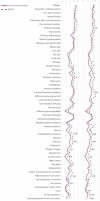Brain fog of post-COVID-19 condition and Chronic Fatigue Syndrome, same medical disorder?
- PMID: 36474290
- PMCID: PMC9724286
- DOI: 10.1186/s12967-022-03764-2
Brain fog of post-COVID-19 condition and Chronic Fatigue Syndrome, same medical disorder?
Abstract
Background: Myalgic Encephalomyelitis/Chronic Fatigue Syndrome (ME/CFS) is characterized by persistent physical and mental fatigue. The post-COVID-19 condition patients refer physical fatigue and cognitive impairment sequelae. Given the similarity between both conditions, could it be the same pathology with a different precipitating factor?
Objective: To describe the cognitive impairment, neuropsychiatric symptoms, and general symptomatology in both groups, to find out if it is the same pathology. As well as verify if the affectation of smell is related to cognitive deterioration in patients with post-COVID-19 condition.
Methods: The sample included 42 ME/CFS and 73 post-COVID-19 condition patients. Fatigue, sleep quality, anxiety and depressive symptoms, the frequency and severity of different symptoms, olfactory function and a wide range of cognitive domains were evaluated.
Results: Both syndromes are characterized by excessive physical fatigue, sleep problems and myalgia. Sustained attention and processing speed were impaired in 83.3% and 52.4% of ME/CFS patients while in post-COVID-19 condition were impaired in 56.2% and 41.4% of patients, respectively. Statistically significant differences were found in sustained attention and visuospatial ability, being the ME/CFS group who presented the worst performance. Physical problems and mood issues were the main variables correlating with cognitive performance in post-COVID-19 patients, while in ME/CFS it was anxiety symptoms and physical fatigue.
Conclusions: The symptomatology and cognitive patterns were similar in both groups, with greater impairment in ME/CFS. This disease is characterized by greater physical and neuropsychiatric problems compared to post-COVID-19 condition. Likewise, we also propose the relevance of prolonged hyposmia as a possible marker of cognitive deterioration in patients with post-COVID-19.
Keywords: Brain fog; Cognition; Hyposmia; Myalgic Encephalomyelitis/Chronic Fatigue Syndrome; Neuropsychological impairment; Post-COVID-19 condition; SARS-CoV-2.
© 2022. The Author(s).
Conflict of interest statement
Nothing to report.
Figures





References
-
- Friedberg F, Ph D. ME/CFS . A primer for clinical practitioners members of the IACFS/ME primer writing committee. International association for chronic fatigue. Published online 2012.
Publication types
MeSH terms
LinkOut - more resources
Full Text Sources
Medical
Research Materials
Miscellaneous

